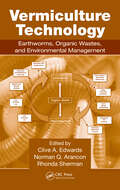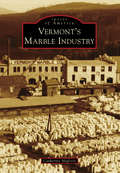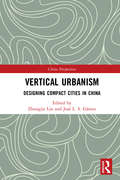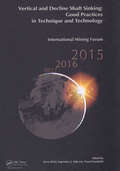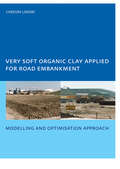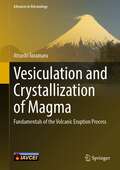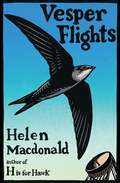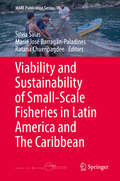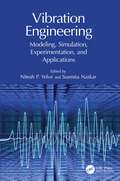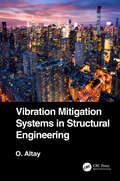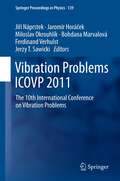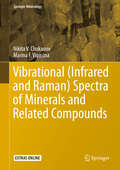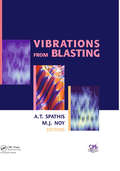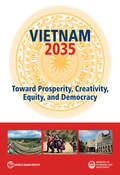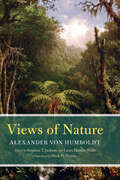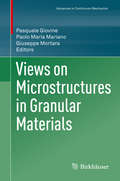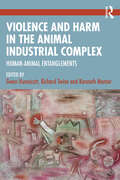- Table View
- List View
Vermiculture Technology: Earthworms, Organic Wastes, and Environmental Management
by Rhonda Sherman Clive A. Edwards Norman Q. AranconCo-edited by international earthworm expert Clive A. Edwards, Vermiculture Technology: Earthworms, Organic Wastes, and Environmental Management is the first international, comprehensive, and definitive work on how earthworms and microorganisms interact to break down organic wastes on a commercial basis. Many books cover the importance of composting
Vermont's Marble Industry
by Catherine MiglorieThe marble deposits in Vermont are some of the richest in the world. Vermont's Marble Industry takes readers deep inside the quarries of the Green Mountain State to show how stone was sawed and raised from the earth to be cut, polished, and carved into monuments and structures that today are spread across the country. During the late 1800s, the marble industry flourished and the mighty Vermont Marble Company was started by a local family. The patriarch of the Proctor family built the Vermont Marble Company into the largest stone company in the world. They hired immigrant workers to fuel the company, and the region became a melting pot of nationalities. After World War II, demand for blocks of heavy dimension stone diminished and the slow demise of the Vermont Marble Company began. Vermont's Marble Industry proudly tells the history of the marble workers, their skilled craftsmanship, and the communities that relied on this industry.
Vernacular Regeneration: Low-income Housing, Private Policing and Urban Transformation in inner-city Johannesburg
by Aidan MosselsonUrban regeneration is currently taking place in inner-city Johannesburg. This book presents an alternative, multi-layered account for reading the process of urban change and renewal. The provision of social and affordable housing and the spread of private security are explored through the lenses of neoliberal urbanism, gentrification, the privatisation of public space and revanchist policing. This book interrogates these concepts and challenges their assumptions based on new qualitative and ethnographic evidence emerging out of Johannesburg. Dated concepts in Critical Urban Studies are re-evaluated and the book calls for an alternative, adaptable approach, focusing on how we develop a vocabulary and creative understanding of urban regeneration. This book is an outstanding contribution to theoretical and comparative approaches to understanding cities and processes of urban change. It offers practical insights and experiences which will be of considerable use to practitioners, policy-makers and urban planning students.
Vertical Urbanism: Designing Compact Cities in China (China Perspectives)
by Zhongjie Lin José L. GámezStudies of compact cities have evolved along with the rising awareness of climate change and sustainable development. Relevant debates, however, reveal that the prevailing definitions and practices of compact cities are tied primarily to traditional Western urban forms. This book reinterprets "compact city", and develops a ground-breaking discourse of "Vertical Urbanism", a concept that has never been critically articulated. It emphasizes "Vertical Urbanism" as a dynamic design strategy instead of a static form, distinguishing it from the stereotyped concept of "vertical city" or "towers in the park" dominant in China and elsewhere, and suggests its adaptability to different geographic and cultural contexts. Using Chinese cities as laboratories of investigation, this book explores the design, ecological, and sociocultural dimensions of building compact cities, and addresses important global urban issues through localized design solutions, such as the relationship between density and vitality, the integration of horizontal and vertical dimensions of design, and the ecological and social adaptability of combinatory mega-forms. In addition, through discussions with scholars from the United States, China, and Japan, this book provides an insight into the theoretical debates surrounding "compact city" and "Vertical Urbanism" in the global context. Scholars and students in architecture and urban planning will be attracted by this book. Also, it will appeal to readers with an interest in urban development and Asian studies.
Vertical and Decline Shaft Sinking: Good Practices in Technique and Technology, International Mining Forum 2015
by Jerzy KickiShaft sinking for underground transportation purposes is a very complex technological process in mining and geotechnology which requires specific and specially designed technological equipment. This technological process is dealt with for a long time, since mining is one of the oldest industries in the world.This book presents the te
Very British Weather: Over 365 Hidden Wonders from the World’s Greatest Forecasters
by The Met OfficeUPGRADE YOUR SMALL TALK GUIDED BY WORLD-LEADING WEATHER EXPERTS!From Foggy and Freezing to Scorching and Stormy, join the ultimate weather adventure through the great British seasons and uncover the extraordinary in every single day*.Are YOU the ultimate weather watcher?Do you know your drizzle from your mizzle?Ever wondered what rainbows are really made of?And could you pinpoint where lightning has struck twice?Pore over beautiful cloudscapes, learn the secrets of sunsets, discover freak weather and fogbows, and why forecasting was so important in British history, from D-Day to the Great Fire of London.Perfect for rainy days in or cloudspotting on the go, the Met Office share the best of almost 170 years of forecasting for the first time in this beautifully illustrated book. Packed with mythbusting, top trivia, stunning visuals and archive gems, shooting the breeze has never been so interesting!*Even when it is tipping it down.
Very Soft Organic Clay Applied for Road Embankment: Modelling and Optimisation Approach, UNESCO-IHE PhD, Delft, the Netherlands
by C. LimsiriIn this book strategies for using very soft organic clay as a fill material for road embankment constructions are compared, and an optimisation scheme is presented. Computer programs for simulation of evaporative drying, for simulation of consolidation, and for slope stability calculation were used to analyse clay behaviour. Field and laboratory te
Vesiculation and Crystallization of Magma: Fundamentals of the Volcanic Eruption Process (Advances in Volcanology)
by Atsushi ToramaruThis book comprehensively illustrates the elemental processes of vesiculation and crystallization recorded in volcanic products on the basis of the equilibrium and non-equilibrium theories. The book describes the derivation of equations and the basic physics behind them in detail. This textbook is fundamental in preparing for future volcanic hazards. The target readers are graduate students and researchers, but Parts I and IV are written to be understandable by undergraduate students as well, to inspire them to enter this field.
Vesper Flights
by Helen MacdonaldAnimals don't exist in order to teach us things, but that is what they have always done, and most of what they teach us is what we think we know about ourselves. In this book, the author brings together a collection of her best loved essays, along with new pieces on topics ranging from nostalgia for a vanishing countryside to the tribulations of farming ostriches to her own private vespers while trying to fall asleep. Meditating on notions of captivity and freedom, immigration and flight, the author invites us into her most intimate experiences: observing the massive migration of songbirds from the top of the Empire State Building, watching tens of thousands of cranes in Hungary, seeking the last golden orioles in Suffolk's poplar forests. She writes with heart-tugging clarity about wild boar, swifts, mushroom hunting, migraines, the strangeness of birds' nests, and the unexpected guidance and comfort we find when watching wildlife.
Vesuvius: A Biography
by Alwyn ScarthThe volcano that has fascinated scientists, writers, and poets for two millenniaCapricious, vibrant, and volatile, Vesuvius has been and remains one of the world's most dangerous volcanoes. In its rage, it has destroyed whole cities and buried thousands alive. In its calm, its ashes have fertilized the soil, providing for the people who have lived in its shadows. For over two millennia, the dynamic presence of this volcano has fascinated scientists, artists, writers, and thinkers, and inspired religious fervor, Roman architecture, and Western literature. In Vesuvius, Alwyn Scarth draws from the latest research, classical and eyewitness accounts, and a diverse range of other sources to tell the riveting story of this spectacular natural phenomenon.Scarth follows Vesuvius across time, examining the volcano's destruction of Pompeii and Herculaneum in 79 A.D., its eruptions during the Counter-Reformation that were viewed as God's punishment of sinners, and the building of the world's first volcano observatory on Vesuvius in the 1840s. Scarth explores the volcano's current position overlooking a population of more than three million people and the complex attitudes maintained by the residents, at once reverent, protective, and fearful. He also considers the next major eruption of Vesuvius, which experts have indicated could be the most powerful since 1631. The longer Vesuvius remains dormant, the more violent its reawakening will be, and despite scientific advances for predicting when this might occur, more people are vulnerable than ever before.Exploring this celebrated wonder from scientific, historical, and cultural perspectives, Vesuvius provides a colorful portrait of a formidable force of nature.
Viability and Sustainability of Small-Scale Fisheries in Latin America and The Caribbean (MARE Publication Series #19)
by Ratana Chuenpagdee María José Barragán-Paladines Silvia SalasOne of the main goals in fisheries governance is to promote viability and sustainability in small-scale fishing communities. This is not an easy task given external and internal pressure, including environmental change and competition with other economic sectors searching for development in the coastal region. A comprehensive understanding of small-scale fisheries in their own context, and from a regional perspective, is an important step in supporting the implementation of the Voluntary Guidelines on Securing Sustainable Small-Scale Fisheries (SSF Guidelines). This book contributes to the global effort by offering knowledge, insights and lessons about small-scale fisheries in Latin America and the Caribbean. The 20 case studies included in the book make explicit the various dimensions that are intrinsic to small-scale fisheries in the region, and identify conditions and situations that affect the wellbeing of fishing communities. The book offers insights regarding the challenges faced by small-scale fisheries in the region, and, aligning with the objectives of the SSF Guidelines, provides lessons and experiences about how to make small-scale fishing communities viable while maintaining sustainable fisheries. This important book illustrates the complexity, diversity, and dynamics of small-scale fisheries in the Latin American and Caribbean region and presents experiences, tools, and approaches to lead towards sustainable and viable fisheries. The reader will gain a new understanding on the range of actions, approaches, and information needed for their successful management. John F. Caddy, International Fisheries ExpertThis book, prepared by the Too Big To Ignore partnership, constitutes a very valuable resource for policy makers, fisheries scientists, non-governmental organizations, civil society organizations, and fishing communities interested in putting in place sound management strategies, research, and actions to contribute to the sustainability of small-scale fisheries and food security in Latin America and the Caribbean region. Juan Carlos Seijo, Professor of Fisheries Bioeconomics at Marist University of Merida
Viaggio nella fisica moderna: Da Einstein alle nuove tecnologie quantistiche
by Carmine GranataIl libro offre un breve viaggio nel sorprendente e spettacolare mondo della fisica moderna caratterizzato da idee e teorie dirompenti sia dal punto di vista concettuale che applicativo. Partendo dalla teoria della relatività di Einstein in cui i concetti di spazio, tempo e gravità vengono completamente rivisti, si arriva al bizzarro e affascinante universo della fisica quantistica che con le sue applicazioni ha cambiato completamente il nostro modo di vivere. Particolare attenzione è inoltre rivolta ai fondamenti concettuali e ai paradossi della meccanica quantistica grazie ai quali si è sviluppata in tempi più recenti la cosiddetta seconda rivoluzione quantistica, destinata a introdurre nelle nostre vite una nuova generazione di tecnologie quantistiche come computer, crittografia e teletrasporto. Oltre alle nuove tecnologie quantistiche, vengono illustrati in modo semplice e conciso i principi di funzionamento delle più importanti applicazioni della meccanica quantistica che si sono diffuse nella vita quotidiana. Il libro ha un carattere essenzialmente informativo, senza ricorrere a formule complicate o tecnicismi, pertanto non richiede conoscenze approfondite di fisica o matematica; le conoscenze acquisite nella scuola superiore sono sufficienti per comprendere gli argomenti trattati.
Vibrant Matter: A Political Ecology of Things
by Jane BennettIn Vibrant Matter the political theorist Jane Bennett, renowned for her work on nature, ethics, and affect, shifts her focus from the human experience of things to things themselves. Bennett argues that political theory needs to do a better job of recognizing the active participation of nonhuman forces in events. Toward that end, she theorizes a "vital materiality" that runs through and across bodies, both human and nonhuman. Bennett explores how political analyses of public events might change were we to acknowledge that agency always emerges as the effect of ad hoc configurations of human and nonhuman forces. She suggests that recognizing that agency is distributed this way, and is not solely the province of humans, might spur the cultivation of a more responsible, ecologically sound politics: a politics less devoted to blaming and condemning individuals than to discerning the web of forces affecting situations and events. Bennett examines the political and theoretical implications of vital materialism through extended discussions of commonplace things and physical phenomena including stem cells, fish oils, electricity, metal, and trash. She reflects on the vital power of material formations such as landfills, which generate lively streams of chemicals, and omega-3 fatty acids, which can transform brain chemistry and mood. Along the way, she engages with the concepts and claims of Spinoza, Nietzsche, Thoreau, Darwin, Adorno, and Deleuze, disclosing a long history of thinking about vibrant matter in Western philosophy, including attempts by Kant, Bergson, and the embryologist Hans Driesch to name the "vital force" inherent in material forms. Bennett concludes by sketching the contours of a "green materialist" ecophilosophy.
Vibration Analysis of Functionally Graded Piezoelectric Actuators (SpringerBriefs in Applied Sciences and Technology)
by Pankaj SharmaThis book presents a detailed study on the vibration analysis of functionally graded piezoelectric actuators excited under the shear effect. Two types of actuator geometries viz. beam and annular plate are considered, where the material properties are assumed to have a continuous variation in accordance with a power law distribution. The generalized differential quadrature method is used to obtain the solutions, and is compared to exact analytical results. The methodology reported and the numerical results presented will be useful for the design of devices utilizing functionally graded piezoelectric actuators under the influence of shear.
Vibration Engineering: Modeling, Simulation, Experimentation, and Applications
by Nitesh P. Yelve Susmita NaskarVibration Engineering presents recent developments in the field of engineering, encompassing industrial norms, applications within the finite element method, infrastructure safety assessment, and active vibration control strategies. It offers a study in seismic vibration control and analysis for building structures and liquid storage tanks.Spanning across the multiple domains of vibration engineering, the book highlights machinery diagnostics, modal analysis, energy harvesting, balancing, vibration isolation, and human-vibration interaction. It discusses experimental fault identification in journal bearings using vibration-based methods. This book also considers advances in vibration-based structural health monitoring of civil infrastructures.This book will be a useful reference for industry professionals and engineers facing challenges while dealing with the vibrations in the fields of mechanical, aerospace, structural, and civil engineering.
Vibration Mitigation Systems in Structural Engineering
by Okyay AltayThe scope of the book is the application of vibration mitigation systems in structural engineering. The intended content includes the theoretical background covering aspects from both structural dynamics and control engineering point of view. Moreover, passive, active and semi-active devices are explained in detail giving mathematical principles, design considerations and application examples. It also contains detailed information about structural monitoring, as an essential part of the active/semi-active systems, and therefore, provide a full overview about passive, active and semi-active systems in the specific context of civil engineering Book presents a comprehensive coverage of the area of vibration control of civil structures subjected to different types of loading while using passive, semi-active, and/or active controls. Presents the theoretical governing equations as well as the associated design guides of various vibration control mitigation approaches. Discusses structural monitoring aspects such as sensor technology, system identification and signal processing topics. Reviews structural control aspects, such as algorithms. Includes solved examples utilizing MATLAB®/SIMULINK® with source codes of the calculation examples and design tool set. This book is aimed at graduate students, professionals, researchers in civil engineering, structural engineering, structural dynamics, health monitoring, vibration control.
Vibration Problems ICOVP 2011
by Bohdana Marvalová Ferdinand Verhulst Jaromír Horáček Jerzy T. Sawicki Jiří Náprstek Miloslav OkrouhlíkThis volume presents the Proceedings of the 10th International Conference on Vibration Problems, 2011, Prague, Czech Republic. ICOVP 2011 brings together again scientists from different backgrounds who are actively working on vibration-related problems of engineering both in theoretical and applied fields, thus facilitating a lively exchange of ideas, methods and results between the many different research areas. The aim is that reciprocal intellectual fertilization will take place and ensure a broad interdisciplinary research field. The topics, indeed, cover a wide variety of vibration-related subjects, from wave problems in solid mechanics to vibration problems related to biomechanics. The first ICOVP conference was held in 1990 at A.C. College, Jalpaiguri, India, under the co-chairmanship of Professor M.M. Banerjee and Professor P. Biswas. Since then it has been held every 2 years at various venues across the World.
Vibrational (Springer Mineralogy)
by Nikita V. Chukanov Marina F. VigasinaThe book presents new data on the IR spectra of minerals and on the Raman spectra of more than 2000 mineral species. It also includes examples of IR spectroscopy applications to investigate minerals, and discusses the most important potential applications of Raman spectroscopy in mineralogical research. The book serves as a reference resource and a methodological guide for mineralogists, petrologists and technologists working in the field of inorganic materials.
Vibrations from Blasting: Workshop hosted by Fragblast 9 - the 9th International Symposium on Rock Fragmentation by Blasting
by A. T. Spathis M. J. NoyCollection of excellent articles presenting the latest developments in blast vibration measurements, modeling and mitigation techniques. Includes contributions on novel environmentally-induced vs blast-induced movements, non-conventional geophysical processing techniques, new modeling approaches, mitigation techniques using smarter blasting methods
Vietnam 2035: Toward Prosperity, Creativity, Equity, and Democracy
by World Bank Group;Ministry of Planning and Investment of VietnamThirty years of Ä?á»*i Má»>i (economic renovation) reforms have catapulted Vietnam from the ranks of the world's poorest countries to one of its great development success stories. Critical ingredients have been visionary leaders, a sense of shared societal purpose, and a focus on the future. Starting in the late 1980s, these elements were successfully fused with the embrace of markets and the global economy. Economic growth since then has been rapid, stable, and inclusive, translating into strong welfare gains for the vast majority of the population. But three decades of success from reforms raises expectations for the future, as aptly captured in the Vietnamese constitution, which sets the goal of "a prosperous people and a strong, democratic, equitable, and civilized country. ? There is a firm aspiration that by 2035, Vietnam will be a modern and industrialized nation moving toward becoming a prosperous, creative, equitable, and democratic society. The Vietnam 2035 report, a joint undertaking of the Government of Vietnam and the World Bank Group, seeks to better comprehend the challenges and opportunities that lie ahead. It shows that the country's aspirations and the supporting policy and institutional agenda stand on three pillars: balancing economic prosperity with environmental sustainability; promoting equity and social inclusion to develop a harmonious middle- class society; and enhancing the capacity and accountability of the state to establish a rule of law state and a democratic society. Vietnam 2035 further argues that the rapid growth needed to achieve the bold aspirations will be sustained only if it stands on faster productivity growth and reflects the costs of environmental degradation. Productivity growth, in turn, will benefit from measures to enhance the competitiveness of domestic enterprises, scale up the benefits of urban agglomeration, and build national technological and innovative capacity. Maintaining the record on equity and social inclusion will require lifting marginalized groups and delivering services to an aging and urbanizing middle-class society. And to fulfill the country's aspirations, the institutions of governance will need to become modern, transparent, and fully rooted in the rule of law.
Views of Nature
by Laura Dassow Walls Alexander Von Humboldt translated by Mark W. Person edited by Stephen T. JacksonPurchase of this book includes free trial access to www. million-books. com where you can read more than a million books for free. This is an OCR edition with typos. Excerpt from book: Modern views on the mountain systems of the two American peninsulas. Chains, which have a direction from S. W. to N. E. , in Brazil and in the Atlantic portion of the United States of North America. Depression of the Province of Chiquitos; ridges as watermarks between the Guapor6 and Aguapehi in 15 and 17 south lat. , and between the fluvial districts of the Orinoco and Eio Negro in 2 and 3 north lat. ?pp. 29-31. Continuation of the Andes-chain north of the isthmus of PanamS through the territory of the Aztecs, (where the Popocatepetl, recently ascended by Capt. Stone, rises to an altitude of 17,720 feet, ) and through the Crane and Rocky Mountains. Valuable scientific investigations of Capt. Fremont. The greatest barometric levelling ever accomplished, representing a profile of the ground over 28 of longitude. Culminating point of the route from the coast of the Atlantic to the South Sea. The South Pass southward of the Wind-River Mountains. Swelling of the ground in the Great Basin. Long disputed existence of Lake Timpanogos. Coast-chain, Maritime Alps, Sierra Nevada of California. Volcanic eruptions. Cataracts of the Columbia River?pp. 31-38. General considerations on the contrast between the configuration of the territorial spaces, presented by the two diverging coast-chains, east and west of the central chain, called the Rocky Mountains. Hypsometric constitution of the Eastern Lowland, which is only from 400 to somewhat more than 600 feet above the level of the sea, and of the arid uninhabited plateau of the Great Basin, from 5000 to more than 6000 feet high. Sources of the Mississippi in Lake Istaca according to Nicollet, whose labours are most meritorious. Native land of the Bisons; their ancient domestication in Northern Mexico asserted by Gomara?pp. 38-42. Retrospectiv. .
Views on Microstructures in Granular Materials (Advances in Mechanics and Mathematics #44)
by Paolo Maria Mariano Pasquale Giovine Giuseppe MortaraThis contributed volume provides an up-to-date overview of the mechanics of granular materials, ranging from sparse media to soils. With chapters exploring state-of-the-art theoretical, experimental, and applied trends in the study of granular matter in various states, readers will be motivated to learn about the current challenges and potential avenues of exploration in this active area of research. Including a variety of perspectives, this volume will be a valuable reference for audiences in a number of fields. Specific topics covered include:X-ray tomography techniques for analyzing sandEvaluation of effective stress in unsaturated soilsHyper-plasticityWave propagation in granular systemsPartly saturated porous mediaMulti-scale approaches to the dynamics of sparse mediaViews on Microstructures in Granular Materials is an ideal resource for PhD students and researchers in applied mathematics, solid-state physics, civil engineering, and mechanical engineering.
Villa Victoria: The Transformation of Social Capital in a Boston Barrio
by Mario Luis SmallFor decades now, scholars and politicians alike have argued that the concentration of poverty in city housing projects would produce distrust, alienation, apathy, and social isolation--the disappearance of what sociologists call social capital. But relatively few have examined precisely how such poverty affects social capital or have considered for what reasons living in a poor neighborhood results in such undesirable effects. This book examines a neglected Puerto Rican enclave in Boston to consider the pros and cons of social scientific thinking about the true nature of ghettos in America. Mario Luis Small dismantles the theory that poor urban neighborhoods are inevitably deprived of social capital. He shows that the conditions specified in this theory are vaguely defined and variable among poor communities. According to Small, structural conditions such as unemployment or a failed system of familial relations must be acknowledged as affecting the urban poor, but individual motivations and the importance of timing must be considered as well. Brimming with fresh theoretical insights, Villa Victoria is an elegant work of sociology that will be essential to students of urban poverty.
Violence and Harm in the Animal Industrial Complex: Human-Animal Entanglements
by Richard Twine Gwen Hunnicutt Kenneth MentorThis book grapples with multispecies violent exploitations embedded in corridors of power within the animal-industrial complex (A-IC). The A-IC is a useful framework for understanding how exploitative human-animal relations are central to capitalist relations and profit accumulation. ‘A-IC-related-violence’ – killing animals for economic gain – has a ripple effect which results in profound consequences for humans as well.This collection of international scholarship explores topics as varied as how A-IC-related-violence is reproduced and sustained through rapidly changing discursive strategies, ideological architecture, and particular cultural forms that elide and legitimize animal cruelty. Several chapters expose collusion between governments, corporations, and academia as central to maintaining dominance of A-IC-related-violence. Other scholars explore the trouble with making the conditions of “meat” production visible – of de-fetishizing meat commodities. The scholarship critically explores dynamic components of an apparatus that enables A-IC-related-violence and harm but is situated within the capitalist order and charts A-IC-related-violence as the key profit-generating practice in select domains of the A-IC.The book unmasks inherent cruelties in a proliferation of social forms that ultimately reflect a socioeconomic system that centralizes capitalist life characterized by endless growth, competitiveness, and profligate consumption. This is essential reading for those engaged in critical criminology, green criminology, violence studies, peace and conflict studies, critical animal studies, or animal rights-oriented scholars.
Violence in Place, Cultural and Environmental Wounding: Cultural and Environmental Wounding (Routledge Research in Culture, Space and Identity)
by Amanda KearneyHuman life is intimately woven into place. Through nations and homelands, monuments and sacred sites it becomes the anchorage point for ethnic, cultural and national identities. Yet it is also place that becomes the battlefield, war zone, mass grave, desecrated site and destroyed landscape in the midst or aftermath of cultural wounding. Much attention has been given to the impact of trauma and violence on human lives across generations, but what of the spaces in which it occurs? How does culturally prescribed violence impact upon place? And how do the non- human species with whom we coexist also suffer through episodes of conflict and violence? By identifying violence in place as a crisis of our times, and by encouraging both the witnessing and the diagnosing of harm, this book reveals the greater effects of cultural wounding. It problematises the habit of separating human life out from the ecologies in which it is held. If people and place are bound through kinship, whether through necessity and survival, or choice and abiding love, then wounding is co- terminus. The harms done to one will impact upon the other. Case studies from Australia, North and South America, Europe and the Pacific, illustrate the impact of violence in place, while supporting a campaign for methodologies that reveal the fullness of the relational bond between people and place. The book will appeal to students and practitioners alike, with interests in cultural and human geography, anthropology, environmental humanities and moral ecology.
